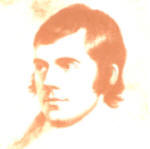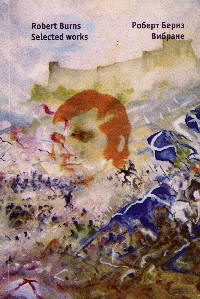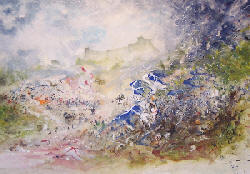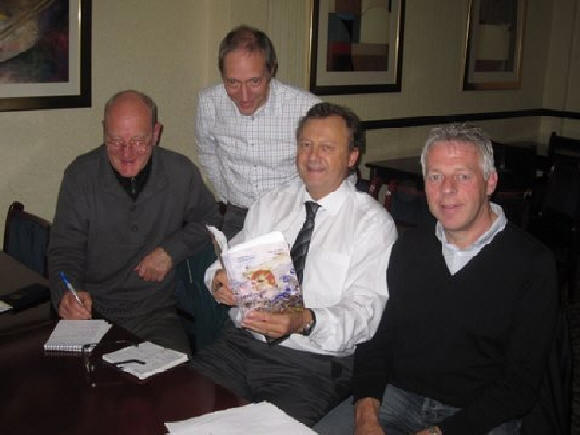|
Edited
by Frank R. Shaw, FSA Scot, Dawsonville, GA, USA
Email:
jurascot@earthlink.net
Last week we
brought you the story of three Ukrainians (Peter, Hanna, and Taya) and this
week we add a Scot, John Clark, a famous Dumfries artist as well as a
published poet. John was asked to provided a cover for ROBERT BURNS SELECTED
WORKS, a book written in both English and Hungarian. It was compiled by
Peter and Hanna. John’s gallery sits close to the Theatre Royal and is
famous for being a place of refuge for Robert Burns. Had he lived, a lot of
scholars feel that the next great adventure for Burns would be play writing.
It would have been the third area to display the genius of Burns, poems and
songs being the first two.
I want to
express my appreciation to one and all for helping with these last two
chapters of Robert Burns Lives! since it is something new for most of us. My
deepest thanks go to Peter, Hanna, and John. Hopefully I will still receive
the story from Taya as to how Burns influenced her life. When and if it
comes in I will add it to last week’s chapter featuring Peter and Hanna.
Below is a letter from John Clark I received about his work on the front
cover of the book.
Next time we
meet I hope to introduce a series of articles to be written over 2014 that
will be a highlight for me. Until then, stay tuned! (FRS: 1.9.a4)
A Letter from
John Clark, Dumfries Artist and Poet
Dear Sir
‘Wars of Independence’
in response to
Hanna Dyka’s request to provide information on the artwork for the recent
translation of Burns into Ukrainian, as the artist, I am pleased to give
details as follows. I also attach some images which you may find
interesting. Full details of my work is available via
www.landscapesgallery.co.uk
 

As
a creative writer I also penned a few lines (shown below) which was used in
the intro to the book.
‘The Battle of Stirling
Bridge’ 1297
In arrogance
they came and went
their prejudice in battle spent
and on that glorious day were slayed –
an’ for their folly dearly paid.
Treachery wad lay brave Wallace low
condemned to die by ‘English law’.
In consequence, mair bluid wad rin
upon the fields o ‘Bannockburn’.
Oor freedom then by Bruce proclaimed
oor independence rightly claimed!’
J Clark
The finished
design was completed using ‘computer software to merge a blurred
version of the wonderful Archibald Skirving sketch, suitable text and a
fragment of the painting shown above. It made a rather striking image (I’m
sure you will agree) and one I feel Burns himself would have been very proud
off. I wonder what he would have thought of the poem…???
The original
painting is owned by a friend of mine (Eric Green) who kindly allowed it to
be displayed at the book launch held in the Ukrainian Consul at the UK book
launch in Edinburgh. It was quite a substantial painting, the medium used
was gouache. Signed A3 - Ltd Edition prints of this painting are available
direct from the website on
www.landscapesgallery.co.uk
How the
painting evolved.
The inspiration
for the painting actually came from a smaller painting of a battle scene I
had completed and sold some months earlier. I used to travel to Gleneagles
Hotel (near Stirling) for business meetings and passed by Stirling Castle
quite often. I was always struck by the impressive battlements,
particularly the outline of the castle which cut into the sky. I have
always been interested in Scottish history, especially the period covering
the ‘wars of independence’, so I decided to paint a larger version of the
small battle scene and include the outline of the castle as it might have
looked in 1297. The suggestion of small crosses and other abstract
marks being sucked up into the sky, represents the souls of those who
died in battle. Although the Scottish Army (mainly foot-soldiers with
spears) were heavily outnumbered that day, the Scots trapped the English by
cleverly luring them across the bridge. The painting works by power
of suggestion rather than detail and you will be hard pressed to
pick out a clear definition of a horse or a knight. The exception to this
is the heavily armoured knight on horseback, surrounded by Scottish Saltires
being up-ended on the bridge. This acts as a focal point for the painting
with the faint, ghost-like silhouette of Stirling Castle in the background.
‘Battle of
Stirling Bridge’ 1297
Once over the
narrow bridge, about five thousand English infantry and 100 men at arms were
easily annexed from the main army (10,000 to 12,000 strong). Recognising
the folly of such an ill-thought action the English commander, John De-
Warenne destroyed the bridge, effectively signing the death warrant for
half his troops. Included in the slaughter was Hugh de Cressingham, the
hated English tax collector who was flayed to death and partially skinned
for his sins. This was the first time heavily armoured English knights
had been defeated in battle (by foot soldiers) as up to that point they were
deemed to be invincible. Although Wallace a clever commander, used the
marshy ground, Brig and loop in the river to devastating effect, it also
helped De-Warenne grossly underestimated the Scottish will to win!
Consequently the English oppressors were duly put to the sword.
The beautiful area surrounding Stirling is steeped in
history. The magnificent Wallace’s Monument, with many artefacts
from the period stands on a hill overlooking the old battlegrounds of
Stirling Brig and Bannockburn. It is well worth a visit. There is a view
‘to die for’ at the top (many did)! Wallace’s brutal death in London
ensured his name would forever be revered as a true Scottish patriot and
paved the way for Robert the Bruce to defeat the English again at
Bannockburn and seal independence for Scotland.
As a Doonhamer
(Dumfries man) and Burns Howff Club member, I was flattered and
honoured to be asked to design the cover, illustrate the book and I trust it
will inspire many students in the Ukraine to read Burns for generations to
come.
Trust you find
the above interesting. Please feel free to edit as required.
Yours sincerely
John Clark

The photograph shows from left to right, Gordon Johnstone (Hon Club
Librarian) and his son Neil ( both past presidents) along with Peter
Kormylo past President and myself (John Clark, artist and Senior Vice
president of the Burns Howff Club). The picture was taken at the Moreig
Hotel on receipt of the first copy of the new book just prior to the
official launch in Edinburgh. |
